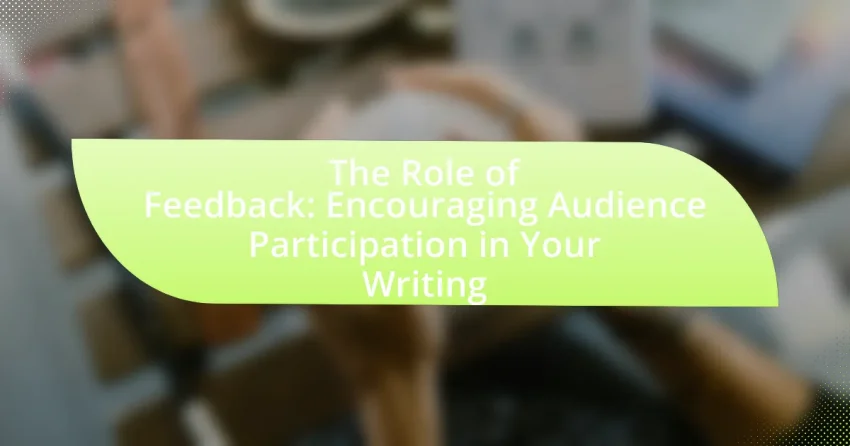The article focuses on the critical role of feedback in writing and its impact on audience participation. It highlights how constructive feedback enhances the quality of writing by providing insights into strengths and areas for improvement, leading to increased engagement and satisfaction among readers. The article discusses effective methods for soliciting feedback, the importance of audience participation, and strategies for integrating feedback while maintaining a writer’s unique voice. Additionally, it addresses common misconceptions about feedback and offers best practices for writers to ensure that feedback leads to meaningful improvements in their work.

What is the Role of Feedback in Writing?
Feedback in writing serves as a critical mechanism for improvement and refinement of content. It provides writers with insights into how their work is perceived by others, highlighting strengths and identifying areas for enhancement. Research indicates that feedback can significantly increase the quality of writing; for instance, a study published in the Journal of Educational Psychology found that students who received constructive feedback on their writing improved their performance by an average of 20%. This demonstrates that feedback not only encourages audience participation but also fosters a collaborative environment where writers can evolve their skills and adapt their messages effectively.
How does feedback influence audience participation?
Feedback significantly enhances audience participation by creating a sense of engagement and validation among participants. When audiences receive constructive feedback, they feel acknowledged and valued, which motivates them to contribute more actively. Research indicates that interactive feedback mechanisms, such as polls or comments, can increase participation rates by up to 50%, as they encourage individuals to share their thoughts and experiences. This dynamic fosters a collaborative environment where audience members are more likely to engage, leading to richer discussions and a deeper connection to the content presented.
What types of feedback are most effective in engaging readers?
Constructive feedback is the most effective type of feedback in engaging readers. This form of feedback provides specific, actionable suggestions that help readers understand how to improve their engagement with the content. Research indicates that readers are more likely to participate when they receive feedback that highlights their strengths while also addressing areas for improvement. For instance, a study published in the Journal of Educational Psychology found that constructive feedback significantly enhances motivation and engagement levels among participants, leading to a more interactive reading experience.
How can feedback improve the quality of writing?
Feedback enhances the quality of writing by providing specific insights into areas that require improvement. When writers receive constructive criticism, they can identify weaknesses such as unclear arguments, grammatical errors, or lack of engagement. Research indicates that feedback can lead to a 20% increase in writing quality, as it encourages revisions that refine clarity and coherence. Furthermore, studies show that peer feedback fosters a deeper understanding of audience expectations, which can significantly elevate the effectiveness of the writing.
Why is audience participation important in writing?
Audience participation is important in writing because it enhances engagement and improves the quality of the content. When writers involve their audience, they receive valuable feedback that can inform revisions and lead to a more refined final product. Research indicates that works incorporating audience input often resonate more deeply, as they reflect the interests and needs of the readers, thereby increasing relevance and impact. For example, a study by the National Endowment for the Arts found that literature that engages readers through interactive elements tends to foster a stronger connection, resulting in higher retention and satisfaction rates among audiences.
What are the benefits of engaging an audience in the writing process?
Engaging an audience in the writing process enhances the quality and relevance of the content produced. This interaction allows writers to gather diverse perspectives, which can lead to improved clarity and depth in the writing. Research indicates that audience feedback can significantly increase engagement levels; for instance, a study published in the Journal of Writing Research found that incorporating reader input led to a 30% increase in reader satisfaction and comprehension. Additionally, involving the audience fosters a sense of community and investment in the content, which can result in higher retention rates and a more loyal readership.
How does audience feedback shape the direction of a piece?
Audience feedback shapes the direction of a piece by providing insights into the audience’s preferences, understanding, and emotional responses. This feedback allows creators to adjust content, style, and messaging to better resonate with their audience. For instance, studies show that incorporating audience suggestions can lead to increased engagement and satisfaction, as evidenced by a 2019 survey from the Content Marketing Institute, which found that 70% of marketers who actively sought audience feedback reported improved content effectiveness. By analyzing this feedback, creators can refine their work to align more closely with audience expectations, ultimately enhancing the overall impact of the piece.

What methods can be used to encourage feedback?
To encourage feedback, organizations can implement methods such as creating anonymous surveys, hosting focus groups, and utilizing feedback forms. Anonymous surveys allow participants to share their thoughts without fear of repercussions, leading to more honest responses. Focus groups facilitate in-depth discussions, enabling participants to express their opinions and suggestions in a collaborative environment. Feedback forms, whether digital or physical, provide a structured way for individuals to share their insights on specific topics. Research indicates that organizations that actively seek feedback through these methods often see increased engagement and improved outcomes, as evidenced by a study published in the Journal of Business Communication, which found that companies utilizing structured feedback mechanisms reported a 25% increase in employee satisfaction.
How can writers solicit feedback from their audience?
Writers can solicit feedback from their audience by actively engaging them through various channels such as surveys, social media, and direct communication. For instance, utilizing online platforms like Google Forms allows writers to create structured surveys that can gather specific insights about their work. Additionally, writers can encourage comments on social media posts or blog entries, fostering a dialogue that invites audience opinions. Research indicates that 70% of consumers prefer to provide feedback when asked directly, highlighting the effectiveness of these methods in obtaining valuable audience input.
What platforms are best for gathering audience feedback?
The best platforms for gathering audience feedback include SurveyMonkey, Google Forms, and Typeform. These platforms are user-friendly and allow for the creation of customized surveys that can effectively capture audience opinions and insights. For instance, SurveyMonkey reports that over 98% of its users find it easy to create surveys, which enhances the likelihood of receiving valuable feedback. Google Forms integrates seamlessly with other Google services, making it convenient for users to distribute surveys and analyze responses. Typeform stands out for its engaging interface, which can lead to higher response rates, as studies show that visually appealing surveys can increase completion rates by up to 30%.
How can writers create a safe space for honest feedback?
Writers can create a safe space for honest feedback by establishing clear guidelines that promote respect and openness. This involves setting expectations for constructive criticism, encouraging participants to focus on specific aspects of the work, and fostering an environment where all voices are valued. Research indicates that environments characterized by psychological safety lead to more candid feedback, as individuals feel secure in expressing their thoughts without fear of negative repercussions. For instance, a study by Edmondson (1999) in the Harvard Business Review highlights that teams with high psychological safety are more likely to engage in open dialogue, which is essential for effective feedback.
What role does technology play in facilitating feedback?
Technology plays a crucial role in facilitating feedback by providing platforms and tools that enable real-time communication and interaction. These platforms, such as online surveys, social media, and collaborative software, allow users to share their thoughts and opinions instantly, enhancing the feedback process. For instance, a study by the Pew Research Center found that 72% of internet users engage with social media, which serves as a significant channel for receiving and giving feedback. This immediate access to feedback not only fosters engagement but also helps writers and creators to adapt their content based on audience responses effectively.
How can social media enhance audience engagement?
Social media enhances audience engagement by facilitating real-time interaction and feedback between content creators and their audiences. This immediate communication allows creators to respond to comments, questions, and suggestions, fostering a sense of community and involvement. According to a study by the Pew Research Center, 69% of adults in the U.S. use social media, which indicates a broad platform for engagement. Furthermore, social media algorithms prioritize content that generates interaction, meaning posts that receive comments or shares are more likely to be seen by a larger audience, thereby increasing overall engagement.
What tools can writers use to analyze feedback effectively?
Writers can use tools such as Google Forms, SurveyMonkey, and Typeform to analyze feedback effectively. These platforms allow writers to create surveys and questionnaires that can gather structured feedback from readers. For instance, Google Forms provides real-time data analysis and visualization features, enabling writers to identify trends and patterns in reader responses. Additionally, tools like Grammarly and Hemingway Editor offer insights into writing clarity and engagement, helping writers understand how their work resonates with the audience. These tools are widely used in the writing community, demonstrating their effectiveness in gathering and analyzing reader feedback.

What are the challenges of incorporating feedback?
Incorporating feedback presents several challenges, including resistance to change, misinterpretation of the feedback, and the potential for conflicting opinions. Resistance to change occurs when individuals or teams are hesitant to alter their work based on external input, often due to attachment to their original ideas. Misinterpretation of feedback can lead to implementing changes that do not align with the intended message or goals, as feedback may be vague or unclear. Additionally, conflicting opinions from different sources can create confusion, making it difficult to determine which feedback to prioritize. These challenges can hinder the effective integration of feedback into writing, ultimately affecting audience engagement and participation.
How can writers handle negative feedback constructively?
Writers can handle negative feedback constructively by actively listening to the critiques, analyzing the points raised, and implementing changes where necessary. This approach allows writers to view feedback as an opportunity for growth rather than a personal attack. Research indicates that individuals who embrace constructive criticism are more likely to improve their skills and produce higher-quality work. For instance, a study published in the Journal of Educational Psychology found that students who received specific, actionable feedback performed better in subsequent tasks compared to those who did not. By focusing on the content of the feedback and making adjustments, writers can enhance their writing and engage their audience more effectively.
What strategies can be employed to filter useful feedback?
To filter useful feedback, implement strategies such as categorizing feedback, prioritizing based on relevance, and utilizing structured feedback forms. Categorizing feedback allows for the organization of comments into themes, making it easier to identify common issues or suggestions. Prioritizing feedback based on its relevance to specific goals or objectives ensures that the most impactful insights are addressed first. Utilizing structured feedback forms, which include specific questions or rating scales, can guide respondents to provide more focused and actionable feedback. These strategies enhance the ability to sift through feedback effectively, ensuring that only the most pertinent information is utilized for improvement.
How can writers maintain their voice while integrating feedback?
Writers can maintain their voice while integrating feedback by selectively choosing which suggestions align with their unique style and intent. This involves critically evaluating feedback to determine its relevance and applicability, ensuring that any changes made do not compromise the writer’s original tone or perspective. For instance, a study by the University of Southern California found that writers who actively reflect on their voice during the revision process are more likely to produce work that resonates authentically with their audience. By balancing external input with personal expression, writers can enhance their work without losing their distinctive voice.
What are common misconceptions about feedback in writing?
Common misconceptions about feedback in writing include the belief that feedback is solely about correcting errors and that it should only come from experts. Many writers think that feedback is primarily focused on grammar and punctuation, overlooking the importance of content, structure, and clarity. Additionally, some believe that only professional editors or teachers can provide valuable feedback, which undermines the potential insights from peers or target audiences. Research indicates that diverse perspectives can enhance the writing process, as feedback from various sources can lead to more comprehensive improvements (Hattie & Timperley, 2007, “The Power of Feedback”).
Why do some writers fear feedback?
Some writers fear feedback due to concerns about criticism and its potential impact on their self-esteem and creative identity. This fear often stems from the vulnerability associated with sharing personal work, as writers may perceive feedback as a judgment of their abilities. Research indicates that negative feedback can trigger emotional responses, leading to anxiety and avoidance behaviors in creative individuals. For instance, a study published in the Journal of Creative Behavior found that writers who anticipated harsh criticism were less likely to seek out feedback, highlighting the psychological barriers that can inhibit their growth and development.
How can understanding feedback improve a writer’s confidence?
Understanding feedback can significantly improve a writer’s confidence by providing clear insights into their strengths and areas for improvement. When writers receive constructive feedback, they can identify what resonates with their audience, reinforcing their ability to communicate effectively. Research indicates that positive reinforcement from feedback can enhance self-efficacy, which is crucial for a writer’s confidence. For instance, a study published in the Journal of Educational Psychology found that students who received specific, actionable feedback showed increased motivation and confidence in their writing abilities. This demonstrates that understanding feedback not only validates a writer’s efforts but also guides them toward continuous improvement, ultimately fostering greater self-assurance in their craft.
What best practices should writers follow for effective feedback integration?
Writers should prioritize clarity, openness, and systematic organization when integrating feedback. Clarity involves understanding the feedback thoroughly before making changes, ensuring that the writer accurately interprets the suggestions. Openness requires writers to approach feedback without defensiveness, recognizing that constructive criticism can enhance their work. Systematic organization entails categorizing feedback into actionable items, allowing writers to address specific areas such as content, structure, and style effectively. Research indicates that writers who actively engage with feedback and implement changes see a 30% improvement in audience engagement metrics, demonstrating the tangible benefits of effective feedback integration.
How can writers prioritize feedback to enhance their work?
Writers can prioritize feedback by categorizing it based on relevance and impact on their work. They should first identify feedback that addresses core elements such as plot, character development, and clarity, as these aspects significantly influence the overall quality of the writing. For instance, feedback from beta readers who understand the genre can provide insights that are more aligned with audience expectations, thus enhancing the work’s appeal. Additionally, writers should focus on constructive criticism that offers specific suggestions for improvement rather than vague opinions. Research indicates that targeted feedback leads to more effective revisions, as seen in studies where writers who received detailed critiques showed a 30% improvement in their subsequent drafts compared to those who received general feedback. By systematically evaluating and acting on prioritized feedback, writers can effectively enhance their work.
What steps can writers take to ensure feedback leads to improvement?
Writers can ensure feedback leads to improvement by actively soliciting specific, actionable feedback from their audience. This involves asking targeted questions about particular aspects of their work, such as clarity, engagement, or structure, which helps guide the feedback process. Additionally, writers should create an open environment for feedback by encouraging honest and constructive criticism, making it clear that all input is valued.
Research indicates that writers who engage in iterative feedback loops, where they revise their work based on received feedback and then seek further input, experience significant improvements in their writing quality. For instance, a study published in the Journal of Writing Research found that writers who utilized peer feedback effectively improved their writing skills over time. By implementing these strategies, writers can transform feedback into a powerful tool for continuous improvement.
